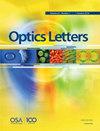利用涡斑增强边缘对比度。
IF 3.3
2区 物理与天体物理
Q2 OPTICS
引用次数: 0
摘要
本文从理论和实验两方面研究了高斯光束和完美光旋涡(POV)光束的部分相干光场对边缘对比度的影响。我们证明,后者允许一个更好地区分对象不连续和提高边缘对比度。我们的研究结果表明,目标检测和识别的主动照明程序可以从使用来自POV的部分相干光提供的额外灵活性中受益。本文章由计算机程序翻译,如有差异,请以英文原文为准。
Edge contrast enhancement using vortex speckles.
We study, theoretically and experimentally, the edge contrast performance when the illumination is provided by partially coherent fields originating from Gaussian or perfect optical vortex (POV) beams. We demonstrate that the latter permits one to better distinguish object discontinuities and improves the edge contrast. Our results suggest that active illumination procedures for target detection and discrimination could benefit from the additional flexibility provided by using partially coherent light from a POV.
求助全文
通过发布文献求助,成功后即可免费获取论文全文。
去求助
来源期刊

Optics letters
物理-光学
CiteScore
6.60
自引率
8.30%
发文量
2275
审稿时长
1.7 months
期刊介绍:
The Optical Society (OSA) publishes high-quality, peer-reviewed articles in its portfolio of journals, which serve the full breadth of the optics and photonics community.
Optics Letters offers rapid dissemination of new results in all areas of optics with short, original, peer-reviewed communications. Optics Letters covers the latest research in optical science, including optical measurements, optical components and devices, atmospheric optics, biomedical optics, Fourier optics, integrated optics, optical processing, optoelectronics, lasers, nonlinear optics, optical storage and holography, optical coherence, polarization, quantum electronics, ultrafast optical phenomena, photonic crystals, and fiber optics. Criteria used in determining acceptability of contributions include newsworthiness to a substantial part of the optics community and the effect of rapid publication on the research of others. This journal, published twice each month, is where readers look for the latest discoveries in optics.
 求助内容:
求助内容: 应助结果提醒方式:
应助结果提醒方式:


